Kew Palace: Rebirth of a Royal Retreat
by Tori V. Martínez
Beautiful as the 17th century Dutch-gabled country house along
the River Thames is, it could hardly be called palatial,
particularly by royal standards, and yet it is one of London's
most notable historic royal palaces. No small feat considering
Kew Palace, which is set within the grounds of the Royal Botanic
Gardens in Kew, is flanked by Windsor Castle 18 miles to the west
and Buckingham Palace eight miles to the east, not to mention
Hampton Court Palace nine miles to the south.
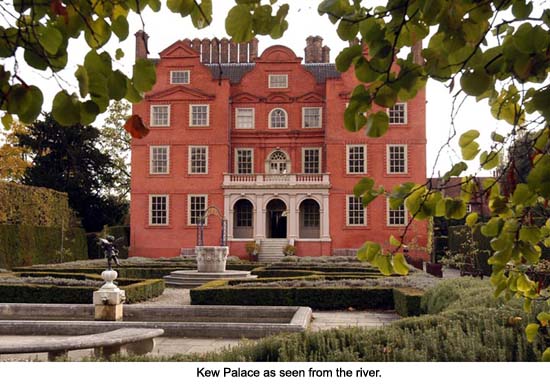
With such magnificent and prominent neighboring royal palaces,
it's little wonder that Kew Palace earned its place in history by
being exactly the opposite -- retiring, modest and comfortable.
In other words, it was the perfect royal retreat. Most famously,
it served as just that for the prodigious family of King George
III and Queen Charlotte and their retinue of servants and
courtiers. Infamously, it even served for a time as the
sanitarium of the "Mad King" during one of his bouts of
so-called insanity.
First opened to the public by Queen Victoria in 1899, the palace
was closed from 1996 to 2006 while undergoing £6.6 million
of careful restoration and conservation. The money and effort
have transformed Kew Palace from "a gaudy 1960s interpretation of
the Georgian era" into a historically accurate study of the daily
life and everyday domesticities of the palace and the royals who
lived within it.
From Rich to Royal
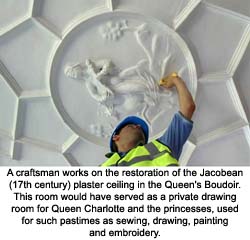 Today, Kew Palace is the oldest remaining building in
Kew's Royal Botanic Gardens, but it was once just one of several
in the area that housed kings George II and III and their
families. The area didn't start out royal, however, and the
origins of Kew Palace go back to 1631 when a successful Flemish
merchant named Samuel Fortrey began building his stately,
three-gabled mansion originally known as the Dutch House. Today, Kew Palace is the oldest remaining building in
Kew's Royal Botanic Gardens, but it was once just one of several
in the area that housed kings George II and III and their
families. The area didn't start out royal, however, and the
origins of Kew Palace go back to 1631 when a successful Flemish
merchant named Samuel Fortrey began building his stately,
three-gabled mansion originally known as the Dutch House.
By the early 18th century, Kew's proximity to the royal palace
Richmond Lodge had attracted the overflow of the growing Georgian
royal family. In 1728, Dutch House became a royal residence when
King George II (r. 1727-1760) leased it for his three daughters.
Just a few years later, in 1731, the King's son and heir,
Frederick, Prince of Wales, leased Kew House (afterward known as
the White House), another stately home just to the south of Kew
Palace (a.k.a. Dutch House). In time, the proximity of Kew Palace
to the White House made it perfect as the private school house
and independent household of Frederick's two sons, the future
George III (r. 1760-1820) and his younger brother.
After Frederick's premature death in 1751, his widow, Princess
Augusta, continued to live in the White House, and is today
credited with establishing the Royal Botanic Gardens at Kew. Her
two sons, meanwhile, continued to reside and be educated in Kew
Palace. Despite a strict schedule, the future king apparently
came to love the palace and its relative privacy. He reaffirmed
that affinity after becoming King George III, when he purchased
Kew Palace for his wife, Queen Charlotte.
As it turned out, it was a wise investment. As each of the
couple's 15 children was born, the need to house them grew
increasingly urgent and, once again, Kew Palace became an outlet
for the royal overflow. Just as had been arranged for the King
and his brother as children, the palace became a school house for
two of his own sons, including the future King George IV (r.
1820-1830), in 1772.
Retreat from Reality
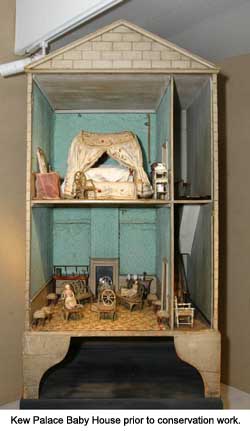 Although George III had
developed a love for Kew as a boy, it was nonetheless against his
will that he went there in November 1788. His
"insanity," most likely caused by the disease
porphyria, had culminated that month at Windsor Castle in a
number of frightening episodes. As a result, his doctors decided
the best place for him was at Kew. There he could have relative
privacy -- an absolute necessity considering his bizarre and
unpredictable behavior. During this first confinement at Kew,
which lasted until April 1789, the King stayed in the White
House, while his family lived in Kew Palace. The situation was
reversed in 1801 when the King was confined to Kew Palace and his
family resided in the White House. Although George III had
developed a love for Kew as a boy, it was nonetheless against his
will that he went there in November 1788. His
"insanity," most likely caused by the disease
porphyria, had culminated that month at Windsor Castle in a
number of frightening episodes. As a result, his doctors decided
the best place for him was at Kew. There he could have relative
privacy -- an absolute necessity considering his bizarre and
unpredictable behavior. During this first confinement at Kew,
which lasted until April 1789, the King stayed in the White
House, while his family lived in Kew Palace. The situation was
reversed in 1801 when the King was confined to Kew Palace and his
family resided in the White House.
Despite all the unhappiness and negative associations, the royal
residences at Kew managed to stay in the good graces of the royal
family and were also used for happier purposes. Kew Palace in
particular was frequently used as a summer residence by the King
and his family between 1800 and 1810. Queen Charlotte and her
four adult daughters seemed to especially enjoy spending time
there in comfortable retreat.
The royal princesses were naturally very interested in keeping
current with the latest trends and are known to have influenced
the interior design and decoration of the palace, much of which
is still evident after 200 years. The modern restoration of Kew
Palace has been particularly careful to restore and recreate
these elements. In some cases, wallpaper and paint have been
carefully reproduced; in others, the only remaining fragments of
the originals have been preserved unaltered. In particular, the
second floor of the palace, which will be opened to the public
for the first time, has remained virtually untouched since the
early 19th century and is being left "with the archeology of
its form exposed."
Decline and Rebirth
Around 1800, during a period of improved health, George III
commissioned architect James Wyatt to build a grand new palace in
Kew, located just to the east of Kew Palace. In 1802, the White
House was demolished to make way for this new "Castellated
Palace." With the White House gone and the grand new palace
under construction, Kew Palace reached its peak of importance to
the royal family. In 1818, two significant events occurred there
to mark this zenith.
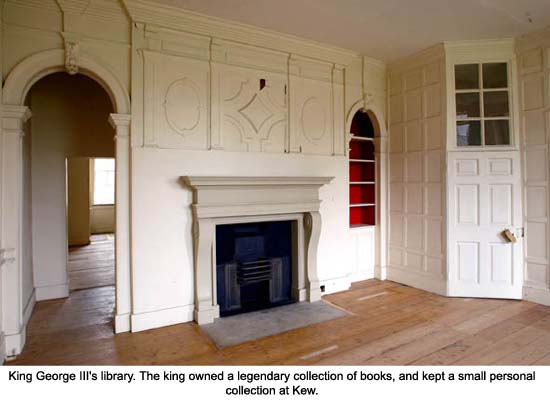
First, in July, the double wedding of the Duke of Clarence and
the Duke of Kent was held in the Queen's Drawing Room in Kew
Palace. As sons of the King and Queen, these two men were
certainly important; but without suitable wives, they meant
little to a monarchy that was in desperate need of an unbroken
line of succession -- hence the critical importance of the
hurried double wedding. Ultimately, the Duke of Clarence, the
elder of the two royal princes, failed to produce an heir for the
Crown, although he did eventually rule as King William IV (r.
1830-1837). His younger brother, the Duke of Kent, didn't live
long enough to come to the throne in his own right, but he did
manage to produce the future Queen Victoria (r. 1837-1901).
But the Victorian Era was still a long way off when the
second significant event of 1818 took place at Kew Palace --
Queen Charlotte's death on November 17. She had spent the last
six months of her life at the royal retreat that held so many
bittersweet memories for her. In a sense, the active life of Kew
Palace also effectively stopped when Queen Charlotte died. The
palace fell into disuse and although most of the furnishings were
removed, it was otherwise left almost exactly as it was upon her
death.
Although the King survived his wife, another attack of his
disease had struck in 1810, leaving him unfit to rule and almost
completely isolated in Windsor Castle while the future George IV
ruled the country as Regent from 1811. Construction on the new
Castellated Palace had largely ceased by 1806, leaving a shell
that was eventually demolished in 1827. Only Kew Palace remained.
Virtually abandoned, it was offered to the Dowager Duchess of
Kent in 1833, just four years before her daughter ascended the
throne as Queen Victoria. She refused on the grounds that the
palace was "very inadequate in accommodation and almost
destitute of furniture."
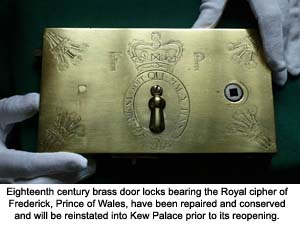 Based on that comment, it's not difficult to imagine
what kind of condition Kew Palace was in when it opened to the
public in 1899, when very little -- if anything -- had ever been
done to change it. Amazingly, it seems very little was even done
to the palace in the 97 years it remained open to the public.
Fortunately, Historic Royal Palaces has taken advantage of this
remarkable snapshot of casual 18th and early 19th century royal
living and restored it to its former self. Based on that comment, it's not difficult to imagine
what kind of condition Kew Palace was in when it opened to the
public in 1899, when very little -- if anything -- had ever been
done to change it. Amazingly, it seems very little was even done
to the palace in the 97 years it remained open to the public.
Fortunately, Historic Royal Palaces has taken advantage of this
remarkable snapshot of casual 18th and early 19th century royal
living and restored it to its former self.
A primary objective of the restoration has been to present the
palace as it was between around 1803 and 1805, when it was at the
peak of its use by King George III and his family. Historic Royal
Palaces has relied on accounts and inventories contemporary to
that period to ensure an accurate and faithful restoration. In
addition to authentic and recreated early 19th century interiors,
visitors will also be able to enjoy some more unusual items
related to the "Mad King," such as a wax life-cast
created by Madam Tussaud, and a shirt and vest worn by him.
Kew Palace is scheduled to reopen to the public Easter 2006 and a
summer festival planned for May 27 to September 24 will highlight
the reopening. The Royal Botanic Gardens, Kew are open year
round, except on Christmas Eve and Christmas Day.
More Information:
We regret that we no longer have the resources to maintain up-to-date links and/or hours and pricing details for the various sites and attractions listed on this website. For more information about the location(s) listed above, please use your favorite search engine or visit Wikipedia.
Tori V. Martínez is a writer and freelance public relations professional who spends as much time as possible researching and writing on her favorite subject -- history. Several years ago, Tori eschewed the life of a full-time career woman to travel and live around the world, particularly in Britain, where she spent considerable time exploring and researching historic destinations. At the moment, she is living in the US with her husband -- a Spaniard she met in England -- and is happily writing for a variety of online and print publications.
Article © 2005 Tori V. Martínez
Photos © Historic Royal Palaces (http://www.newsteam.co.uk)
|
